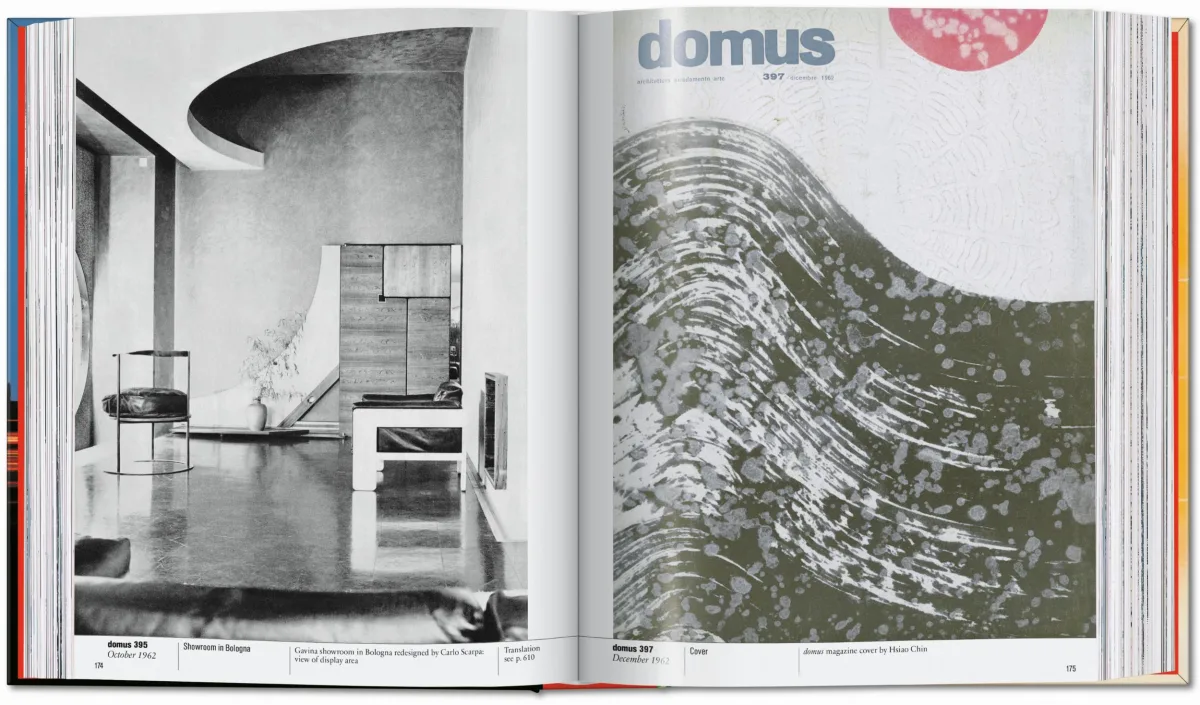1 / 7
domus 1960–1969
40Edition: EnglishAvailability: In StockA freshly revised edition of the 1960s issues of domus, the world’s leading architecture and design journal. With characteristic rigor and style, the magazine documents this decade of futuristic thrill and booming pop culture, from new synthetic materials to avant-garde exploratory forms - featuring Kenzo Tange, Angelo Mangiarotti, and Gio Ponti's fabulous Pirelli Tower.
Hardcover, 7.7 x 10.0 in., 4.59 lb, 640 pages
“There is no finer overview to the design and architecture of the past 75 years than the magazine domus.”

domus 1960s
40Futuristic Thrill
The stars of 60s pop and experimentation
Founded in 1928 as a “living diary” by the great Milanese architect and designer Gio Ponti, domus has been hailed as the world’s most influential architecture and design journal. With both style and rigor, it has offered consistent coverage of major themes and stylistic movements in product, structure, interior, and industrial design.
This fresh reprint features the highlights from the 1960s issues and documents the daring, practical, and beautiful projects of a decade of futuristic thrill and booming pop culture. Synthetics and plastics hit the stage, leading to radical new design, while conventional notions of elegance give way to fresh exploratory forms.
For work to be featured in the magazine it had to offer function, spatial clarity, intellectual persuasion, relevant originality, and/or grace. Those projects and practitioners that made the grade include Ray and Charles Eames, Gae Aulenti, Kenzo Tange, Verner Panton, Achille and Pier Giacomo Castiglioni, Ettore Sottsass, Carlo Scarpa, Angelo Mangiarotti, Cesare Maria Casati, and Eero Saarinen.
domus distilled
This fresh reprint features the highlights from the 1960s issues and documents the daring, practical, and beautiful projects of a decade of futuristic thrill and booming pop culture. Synthetics and plastics hit the stage, leading to radical new design, while conventional notions of elegance give way to fresh exploratory forms.
For work to be featured in the magazine it had to offer function, spatial clarity, intellectual persuasion, relevant originality, and/or grace. Those projects and practitioners that made the grade include Ray and Charles Eames, Gae Aulenti, Kenzo Tange, Verner Panton, Achille and Pier Giacomo Castiglioni, Ettore Sottsass, Carlo Scarpa, Angelo Mangiarotti, Cesare Maria Casati, and Eero Saarinen.
domus distilled
- Seven volumes spanning 1928 to 1999
- Over 4,000 pages featuring influential projects by the most important designers and architects
- Original layouts and all covers, with captions providing navigation and context
- Introductory essays by renowned architects and designers
- Each edition comes with an appendix featuring texts translated into English, many of which were previously only available in Italian
- A comprehensive index in each volume listing both designers’ and manufacturers’ names
The editor
Charlotte and Peter Fiell are well-known design authors having written over sixty books on the subject. Among their various areas of specialization is the realm of transportation design in all its diverse forms. The Fiells have lectured widely, guest taught courses, curated exhibitions, and consulted manufacturing companies, museums, salerooms, and major private collectors around the world. Together, they have written numerous TASCHEN books.
domus 1960–1969
Hardcover, 19.6 x 25.5 cm, 2.08 kg, 640 pagesISBN 978-3-8365-9385-4
Edition: EnglishDownload product images here
4
Compilation re-composée d'une compilation
August 29, 2023
Excellente idée de ré-éditer cette remarquable compilation de la revue "Domus".
Quelques petites précisions en complément de la présentation de ces volumes à l'attention des personnes qui ont pu avoir entre les mains la précédente édition (de 2008) :
- Les 12 volumes originaux de 600 pages sont ici rassemblés en 7 vol de 640 pages (par ex., le volume "1960-1969" "rassemble" les deux volumes précédents "1960-1964" et "1965-1969") ;
- Le format est passé de 23x32 à 19x25 ;
- La maquette comporte un certain nombre de différences, notamment dans la composition des pages (par ex. sur une même page, des photos peuvent "sauter" et d'autres être aggrandies en compensation) ;
- Si forcément un grand nombre de pages de l'édition 2008 ont du disparaitre (on passe quand même d'un total de 7200 à 4480 pages !) il semble aussi que Taschen ait choisi de glisser quelques pages nouvelles car, pour rappel, ces volumes - qu'il s'agisse de l'édition 2023 comme de la 2008 - ne représentent qu'un choix de reproduction de planches de la revue italienne d'origine dont chaque numéro comportait une soixantaine de pages (on pourra donc parler à propos de cette nouvelle édition de : "compilation re-composée d'une compilation") ;
- Et il faudrait aussi préciser - comme c'était évidemment le cas de l'édition 2008 - que la reproduction des pages originelles de la revue comporte des légendes en italien seul. Seuls les textes synthétiques de bas de page sont en anglais et (en supposant que cette nouvelle édition ait fait de même puisque Taschen indique "édition : anglais") les différents essais devraient avoir leur traduction en anglais en fin de volume ;
- Enfin (puisqu'à l'heure où j'écris ce commentaire, le volume 1990-1999 n'est pas encore paru) il faut espérer que, comme en 2008, Taschen fournira avec l'ultime tome l'indispensable index numérisé de l'ensemble comme c'était le cas avec le CD-Rom inclus dans le vol 12 "1995-1999".










